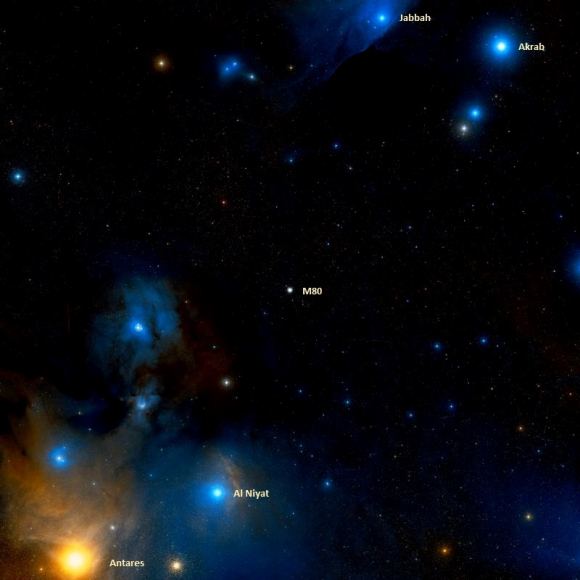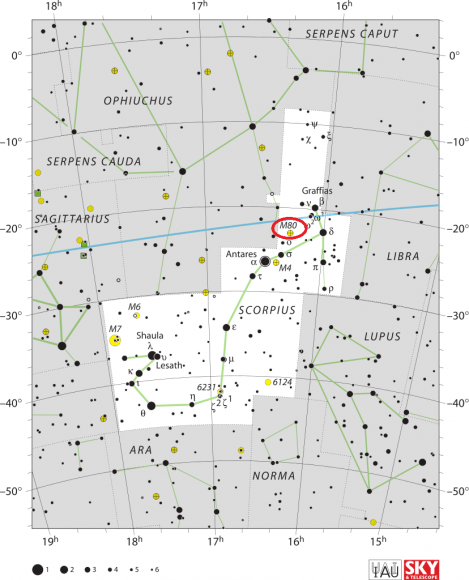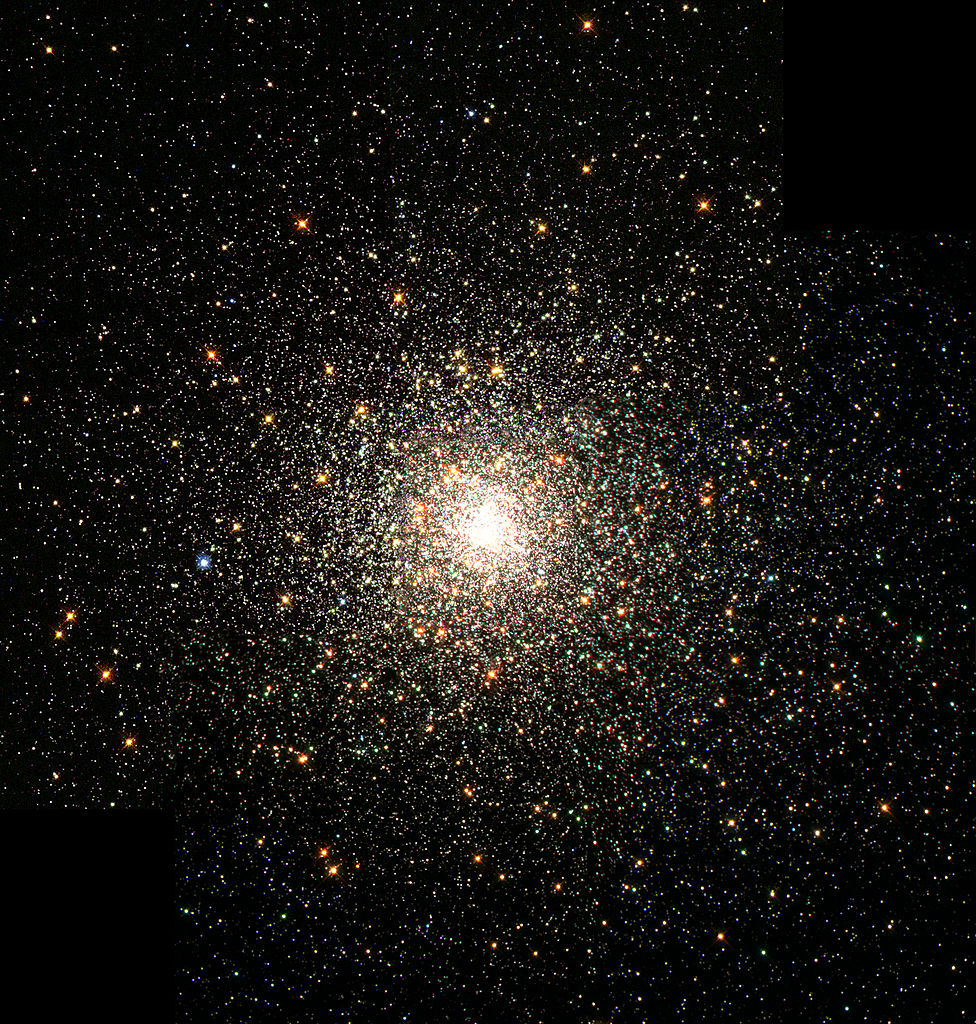Welcome back to Messier Monday! Today, we continue in our tribute to our dear friend, Tammy Plotner, by looking at the globular cluster known as Messier 80!
During the 18th century, famed French astronomer Charles Messier noticed the presence of several “nebulous objects” while surveying the night sky. Originally mistaking these objects for comets, he began to catalog them so that others would not make the same mistake. Today, the resulting list (known as the Messier Catalog) includes over 100 objects and is one of the most influential catalogs of Deep Space Objects.
One of these objects is Messier 80, a globular star cluster located about 32,600 light years from Earth in the constellation Scorpius. This cluster is one of the most densely populated in our galaxy and is located about halfway between the bright stars Antares, Alpha Scorpii, Akrab and Beta Scorpii – making it relatively easy to find.
What You Are Looking At:
This incredibly dense globular cluster is home to hundreds of thousands of stars – all packed tightly together in a sphere measuring about 95 light years in diameter. While Messier 80 lay at the incredible distance of 32,600 light years from our solar system, the amount of candlepower it puts out makes it shine at a healthy magnitude 8 and it holds court as one of the most dense of all known Milky Way globulars. So what does knowing magnitudes help with when it comes to study? Because sometimes old things become new again…

Said Michael Shara of the Space Telescope Science Institute in a 2000 study:
“Novae are expected to form in all stellar systems with a binary population. Detection of extragalactic novae provides direct evidence of close binary populations and possible spatial variations in those populations. Comparison of extragalactic novae with their local counterparts can yield valuable tests of close binary evolution theory. I report early results from surveys of globular clusters, the Large Magellanic Cloud and M81 for classical novae in eruption and in quiescence. T Sco, the nova of 1860 A.D. in the globular cluster M80, has now been recovered. It is three magnitudes fainter than canonical old novae, though this might be an inclination effect. Seven quiescent old novae in the Large Magellanic Cloud have been recovered (at brightnesses comparable to their Galactic counterparts). Their orbital periods are now within reach.”
And sometimes they don’t just go nova… They can go supernova! As Matthew J. Benacquista indicated in a 2002 study:
“As an old population of stars, globular clusters contain many collapsed and degenerate objects. As a dense population of stars, globular clusters are the scene of many interesting close dynamical interactions between stars. These dynamical interactions can alter the evolution of individual stars and can produce tight binary systems containing one or two compact objects. Globular cluster evolution will focus on the properties that boost the production of hard binary systems and on the tidal interactions of the galaxy with the cluster, which tend to alter the structure of the globular cluster with time. The interaction of the components of hard binary systems alters the evolution of both bodies and can lead to exotic objects. Depending on the details of the mass exchange and the evolutionary stage of the mass-losing star there are several outcomes that will lead to the formation of a relativistic binary. The primary star can lose its envelope, revealing its degenerate core as either a helium, carbon-oxygen, or oxygen-neon white dwarf; it can explode as a supernova, leaving behind a neutron star or a black hole; or it can simply lose mass to the secondary so that they change roles. Barring disruption of the binary, its evolution will then continue. In most outcomes, the secondary is now the more massive of the two stars and it may evolve off the main sequence to fill its Roche lobe. The secondary can then initiate mass transfer or mass loss with the result that the secondary also can become a white dwarf, neutron star, or black hole.”
History of Observation:
Thankfully Charles Messier wasn’t in a black hole when he discovered M80 on the night of January 4, 1781. In his notes he wrote:
“Nebula without star, in Scorpius, between the stars Rho Ophiuchi and Delta, compared to determine its position: this nebula is round, the center brilliant, and it resembles the nucleus of a small Comet, surrounded with nebulosity. M. Mechain saw it on January 27, 1781.”
Three years later, Sir William Herschel wouldn’t see nebulosity – he’d see stars. In his private notes he wrote:
“A globular cluster of extremely minute and very compressed stars of about 3 or 4 minutes in diameter; very gradually much brighter in the middle; towards the circumference the stars are distinctly seen, and are the smallest imaginable.”
Some fifty years later, Admiral Smyth would add his own notes to M80’s historic record:
“A compressed globular cluster of very minute stars, on the right foot of Ophiuchus, which is on Scorpio’s back. This fine and bright object was registered by Messier in 1780, who described it as resembling the nucleus of a comet; and indeed, from the blazing centre and attenuated disc, it has a very cometary aspect. There are some small stars both above and below its following parallel, of which three of those in the north form a coarse triangle; but the field and the vicinity are otherwise barren. An early star of Ophiuchus, No. 17 P. XVI., slightly precedes this splendid conglomerate, about half a degree to the northward, and though only of the 8th magnitude, is a convenient index to approach to the out-door gazer. Such particulars are not needed by the man with fixed instruments, but will greatly facilitate the operations of those who are more remarkable for intellectual energy than for means. The mean apparent place is differentiated from Delta Scorpii, from which it lies east, at 4 deg distance; and it is mid-way between Alpha and Beta Scorpii.
“This is a very important object when nebulae are considered in their relations to the surrounding spaces, which spaces, Sir William Herschel found, generally contain very few stars: so much so, that whenever it happened, after a short lapse of time, that no star came into the field of his instrument, he was accustomed to his assistant, “Make ready to write, Nebulae are just approaching.” Now our present object is located on the western edge of a vast obscure opening, or space of 4 deg in breadth, in which no stars are to be seen; and Sir William pronounced 80 Messier, albeit it had been registered as nébuleuse sans étoiles [nebula without stars], to be the richest and most condensed mass of stars which the firmament can offer to the contemplation of astronomers.”
Contemplate it… I dare you!
Locating Messier 80:
Don’t you just love a Messier object that’s easy to find? Just aim your binoculars or telescope finderscope almost exactly half-way between Antares (Alpha Scorpii) and Graffias (Beta Scorpii) and you’ll easily pick up this little powerpunch globular cluster!
M80 is truly a firecracker… What it lacks in size, it makes up for in brightness and concentration. Easily seen in small binoculars and the finderscope as a “hairy” looking ball slightly larger than a star and easily recognizable as a globular cluster in larger binoculars and a small telescope, you’re going to love what happens when aperture comes into play. Just try to resolve this one! M80 is very well suited to urban skies, moderately light polluted sky conditions and even a surprising amount of moonlight.

And here are the quick facts to help you get started:
Object Name: Messier 80
Alternative Designations: M80, NGC 6093
Object Type: Class II Globular Cluster
Constellation: Scorpio
Right Ascension: 16 : 17.0 (h:m)
Declination: -22 : 59 (deg:m)
Distance: 32.6 (kly)
Visual Brightness: 7.3 (mag)
Apparent Dimension: 10.0 (arc min)
We have written many interesting articles about Messier Objects and globular clusters here at Universe Today. Here’s Tammy Plotner’s Introduction to the Messier Objects, M1 – The Crab Nebula, Observing Spotlight – Whatever Happened to Messier 71?, and David Dickison’s articles on the 2013 and 2014 Messier Marathons.
Be sure to check out our complete Messier Catalog. And for more information, check out the SEDS Messier Database.
Sources:

